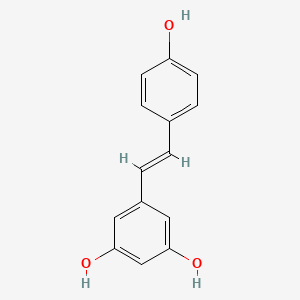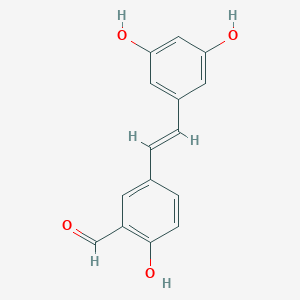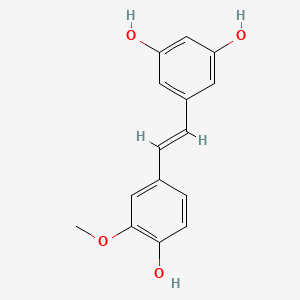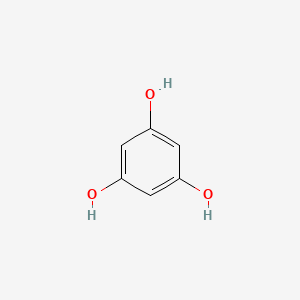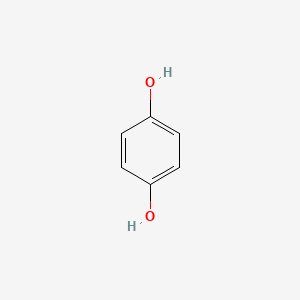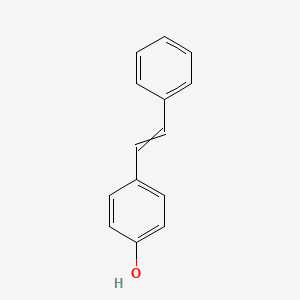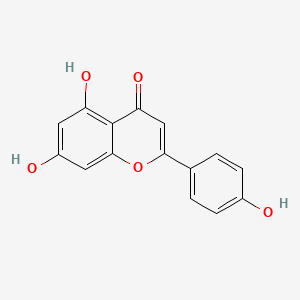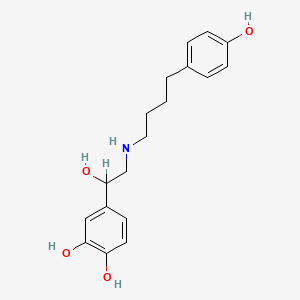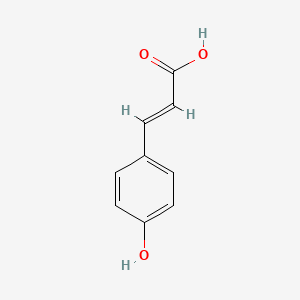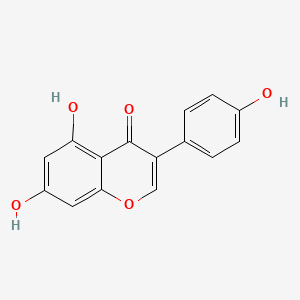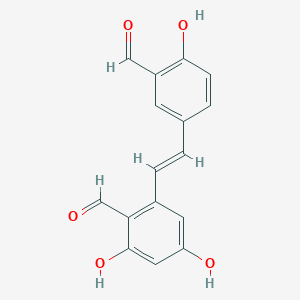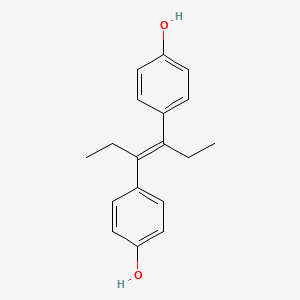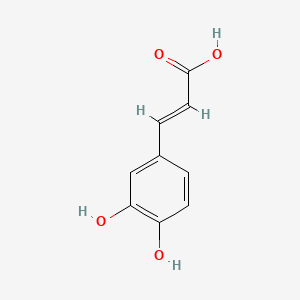| Synonyms |
resveratrol; 501-36-0; trans-resveratrol; 3,4',5-Trihydroxystilbene; 3,5,4'-Trihydroxystilbene; (E)-5-(4-Hydroxystyryl)benzene-1,3-diol; (E)-resveratrol; Resvida; 5-[(E)-2-(4-hydroxyphenyl)ethenyl]benzene-1,3-diol; 3,4',5-Stilbenetriol; 3,4',5-Trihydroxy-trans-stilbene; SRT-501; SRT501; SRT 501; 3,5,4'-Trihydroxy-trans-stilbene; (E)-5-(p-Hydroxystyryl)resorcinol; Cuspidatin; Resveratol; Biofort; 5-[(1E)-2-(4-Hydroxyphenyl)ethenyl]-1,3-benzenediol; trans-3,4',5-trihydroxystilbene; Resveratrol p 5; 5-[(E)-2-(4-hydroxyphenyl)vinyl]benzene-1,3-diol; Resveratrol(e)-form; 5-[2-(4-hydroxyphenyl)ethenyl]benzene-1,3-diol; CHEBI:45713; Melinjo resveratrol 20; C14H12O3; Srt 501m; 1,3-Benzenediol, 5-[(1E)-2-(4-hydroxyphenyl)ethenyl]-; CHEMBL165; NSC-327430; (E)-5-[2-(4-hydroxyphenyl)ethenyl]-1,3-benzendiol; 5-((1E)-2-(4-Hydroxyphenyl)ethenyl)-1,3-benzenediol; MLS000069735; 1,3-Benzenediol, 5-(2-(4-hydroxyphenyl)ethenyl)-, (E)-; Ca 1201; trans-3,4',5 - trihydroxystilbene; BIA 6-512; BIA-6-512; NSC327430; Q369O8926L; SMR000058206; DSSTox_CID_11980; DSSTox_RID_78898; DSSTox_GSID_31980; 133294-37-8; MFCD00133799; STL; 3,4',5-trihydroxy-stilbene; SR-01000000163; trans-1,2-(3,4',5-Trihydroxydiphenyl)ethylene; NSC 327430; CHEBI:27881; CCRIS 8952; UNII-Q369O8926L; HSDB 7571; 3fts; 4jaz; 4qer; Resveratrol, E-; Resveratrol,(S); KUC104385N; Stilbene, 2f; TaxusChinensisiRehd; NCGC00015894-02; CAS-501-36-0; Prestwick_619; Resveratrol, trans-; KSC-10-164; RM-1812; Opera_ID_586; RESVERATROL [MI]; Prestwick2_000508; Prestwick3_000508; Spectrum5_000552; RESVERATROL [HSDB]; RESVERATROL [INCI]; R 5010; RESVERATROL [VANDF]; 1,3-Benzenediol, 5-[(1Z)-2-(4-hydroxyphenyl)ethenyl]-; RESVERATROL [MART.]; Lopac0_001111; REGID_for_CID_6240; SCHEMBL19425; BSPBio_000435; BSPBio_001114; BSPBio_003461; RESVERATROL [WHO-DD]; MLS001055357; MLS001076538; MLS001424228; MLS002207121; MLS002222231; SPECTRUM1502223; CU-01000001503-3; BPBio1_000479; cid_445154; GTPL8741; SGCUT00007; ZINC6787; Resveratrol, analytical standard; DTXSID4031980; REGID_for_CID_445154; BDBM23926; Resveratrol, >=99% (HPLC); AMY5760; 2l98; BCPP000091; HMS1362H15; HMS1569F17; HMS1792H15; HMS1921N04; HMS1990H15; HMS2052I09; HMS2096F17; HMS2232A18; HMS3263O04; HMS3403H15; HMS3412O14; HMS3649A20; HMS3676O14; TRANS-RESVERATROL [USP-RS]; ACT09778; BCP01416; to_000079; Tox21_110257; Tox21_201374; Tox21_303376; Tox21_501111; AC-727; BBL028252; CCG-38874; HB4055; LMPK13090005; s1396; STL146386; AKOS005720936; Tox21_110257_1; CS-1050; DB02709; KS-5047; LP01111; NC00349; SDCCGMLS-0002998.P003; SDCCGSBI-0051080.P003; IDI1_002152; NCGC00017352-05; NCGC00017352-06; NCGC00017352-07; NCGC00017352-08; NCGC00017352-09; NCGC00017352-10; NCGC00017352-11; NCGC00017352-12; NCGC00017352-13; NCGC00017352-14; NCGC00017352-15; NCGC00017352-16; NCGC00017352-17; NCGC00017352-18; NCGC00017352-19; NCGC00017352-24; NCGC00017352-31; NCGC00017352-39; NCGC00024003-00; NCGC00024003-04; NCGC00024003-05; NCGC00024003-06; NCGC00024003-07; NCGC00024003-08; NCGC00024003-09; NCGC00024003-10; NCGC00024003-11; NCGC00024003-12; NCGC00024003-13; NCGC00024003-14; NCGC00257465-01; NCGC00258925-01; NCGC00261796-01; AS-12413; HY-16561; EU-0101111; R0071; Resveratrol, Vetec(TM) reagent grade, 98%; SW196786-4; trans [2,5,4'-trihydroxydiphenyl] ethylene; 01R360; C03582; N88795; 5-[2-(4-hydroxyphenyl)vinyl]-1,3-benzenediol; AB00052942-29; AB00052942_31; trans-Resveratrol 100 microg/mL in Acetonitrile; A827984; Q407329; 5-[(E)-2-(4-Hydroxyphenyl)vinyl]-1,3-benzoldiol; SR-01000000163-3; SR-01000000163-4; SR-01000000163-9; 5-[(E)-2-(4-Hydroxyphenyl)ethenyl]benzol-1,3-diol; 5-[(E)-2-(4-Hydroxyphenyl)vinyl]-1,3-benzenediol; 5[(E)-2-(4-Hydroxyphenyl)-vinyl]benzene 1,3-diol; BRD-K25591257-001-01-2; BRD-K80738081-001-06-2; BRD-K80738081-001-07-0; BRD-K80738081-001-09-6; BRD-K80738081-001-10-4; BRD-K80738081-001-23-7; SR-01000000163-10; SR-01000000163-11; SR-01000000163-16; (E)-1-(3,5-dihydroxyphenyl)-2-(4-hydroxyphenyl)ethene; (E)1-(3,5-dihydroxyphenyl)-2-(4-hydroxyphenyl)ethene; 5-[(1E)-2-(4-Hydroxyphenyl)ethenyl]-1,3,benzenediol; Resveratrol, certified reference material, TraceCERT(R); 1,3-Benzenediol, 5-[(E)-2-(4-hydroxyphenyl)ethenyl]-; Resveratrol, European Pharmacopoeia (EP) Reference Standard; 5-((E)-2-(4-HYDROXYPHENYL)-ETHENYL) BENZENE-1,3 DIOL; 533C1DA0-4104-42B5-9D32-9265F40857E4; trans-Resveratrol, United States Pharmacopeia (USP) Reference Standard; 3,4',5-Trihydroxy-trans-stilbene 5-[(1E)-2-(4-hydroxyphenyl)ethenyl]-1,3-benzenediol; (E)-5-(2-(4-hydroxyphenyl)ethenyl)-1,3-benzenediol(E)-5-(2-(4-hydroxyphenyl)ethenyl)-1,3-benzenediol; 31100-06-8
|
